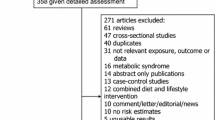Abstract
The effect of nutrition and dietary caffeine consumption and physical activity on bone gain in women during the third decade of life was determined in a longitudinal, descriptive study of 145 healthy college-aged women. Estimates of caffeine and other dietary intakes were determined by repeated 7-day diet diaries. Measurements of bone mineral in the spine and total body mineral content were determined by dual-photon absorptiometry. Measures of physical activity were ascertained by physical activity monitor. The mean estimated caffeine, calcium and protein intakes for the young women students were 103±106 mg/day (mean /+- SEM), 831±334 mg/day (mean ± SEM) and 66±16 g/day (mean ± SEM) respectively. The median rates of bone gain were 5.9% for spine bone mineral content, 6.8% for spine bone mineral density and 12.5% for total body bone mineral. In a multiple regression analysis the significant predictors (+ or −) of the rate of gain were age (−), activity (+), calcium intake (+) and protein intake (−). Caffeine consumption was not associated with significant reduction in rates of bone gain. While calcium and protein nutrition affect bone gain in the third decade of life in women, moderate caffeine intake (one cup of coffee per day, or 103 mg) appears to be safe with respect to bone health in this age group.
Similar content being viewed by others
References
Chapuy M, Arlot M, Duboeuf F, et al. Vitamin D-3 and calcium to prevent hip fractures in elderly women. N Engl J Med 1992;327:1637–42.
Heikinheimo R, Inkovaara J, Harju E, et al. Annual injection of vitamin D and fractures of aged bones. Calcif Tissue Int 1992;51:105–10.
Cumming R. Calcium intake and bone mass: a quantitative review of the evidence. Calcif Tissue Int 1990;47:194–201.
Christiansen C. Prevention and treatment of osteoporosis: a review of current modalities. Bone 1992;13:s35–9.
Heaney R, Recker R, Saville P. Calcium balance and calcium requirements in middle-aged women. Am J Clin Nutr 1977;30:1603–11.
Reid I, Ames R, Evans M, et al. Effect of calcium supplementation on bone loss in postmenopausal women. N Engl J Med 1993;328:460–4.
Recker R, Davies M, Hinders S, et al. Bone gain in young adult women. JAMA 1992;268:2403–8.
Drinkwater B. Exercise in the prevention of osteoporosis. Osteoporosis Int 1993;1 Suppl:s169–71.
Recker R. Prevention of osteoporosis: calcium nutrition. Osteoporosis Int 1993;1 Suppl:s163–5.
Heaney R. Nutritional factors in osteoporosis. Annu Rev Nutr 1993;13:287–316.
Sowers MR, Galuska DA. Epidemiology of bone mass in premenopausal women. Epidemiol Rev 1993;15:374–98.
Cooper C, Atkinson J, Wahner H, O'Fallon M, Riggs L, Judd H, Melton J. Is caffeine consumption a risk factor for osteoporosis? J Bone Miner Res 1992;7:465–71.
Hansen M. Assessment of age and risk factors on bone density and bone turnover in healthy premenopausal women. Osteoporosis Int 1994;4:123–8.
Massey L, Whiting S. Caffeine, urinary calcium, calcium metabolism and bone. J Nutr 1993;123:1611–4.
Barger-Lux J, Heaney R, Stegman M. Effects of moderate caffeine intake on the calcium economy of premenopausal women. Am J Clin Nutr 1990;52:722–5.
Barrett-Connor E, Chang J, Edelstein S. Coffee-associated osteoporosis offset by daily milk consumption. JAMA 1994;271:280–3.
Reid IR. Determinants of the rate of bone loss in normal postmenopausal women. J Clin Endocrinol 1994;79:950–4.
Harris SS, Dawson-Hughes B. Caffeine and bone loss in healthy postmenopausal women. Am J Clin Nutr 1994;60:573–8.
Kiel D, Felson D, Hannan M, et al. Caffeine and the risk of hip fracture: the Framingham study. Am J Epidemiol 1990;132:675–84.
Hernandez-Avila M, Colditz GA, Stampfer MJ, et al. Caffeine, moderate alcohol intake, and risk of fractures of the hip and forearm in middle-aged women. Am J Clin Nutr 1991;54:157–63.
Cumming RG, Klineberg RJ. Case-control study of risk factors for hip fractures in the elderly. Am J Epidemiol 1994;139:493–503.
Barger-Lux MJ, Heaney RP. Caffeine and the calcium economy revisited. Osteoporosis Int 1995;5:97–102.
Yeh J, Aloia J. Differential effect of caffeine administration on calcium and vitamin D metabolism in young and adult rats. J Bone Miner Res 1986;1:25–8.
Heaney R, Recker R. Effects of nitrogen, phosphorus, and caffeine on calcium balance in women. J Lab Clin Med 1982;99:47–55.
Massey LK. Caffeine and bone: directions for research. J Bone Miner Res 1991;6:1149–51.
Daniell H. Osteoporosis of the slender smoker. Arch Intern Med 1976;136:298–304.
Pennington J, editor. Bowes & Church's food values of portions commonly used, 16th ed. Philadelphia: JB Lippincott, 1994.
Pao E, Fleming K, Guenther P, et al. Foods commonly eaten by individuals: amount per day and per eating occasion [abstract]. (report no. 44). (USDA) 1977:23.
National Coffee Association. National coffee drinking study, winter 1990 [abstract].
Maxwell J, Securities WF. Beverage industry. Beverage Industry Annual Manual 1992;[Feb]:10.
Author information
Authors and Affiliations
Rights and permissions
About this article
Cite this article
Packard, P.T., Recker, R.R. Caffeine does not affect the rate of gain in spine bone in young women. Osteoporosis Int 6, 149–152 (1996). https://doi.org/10.1007/BF01623939
Received:
Accepted:
Issue Date:
DOI: https://doi.org/10.1007/BF01623939




